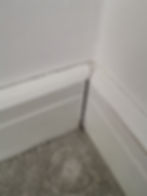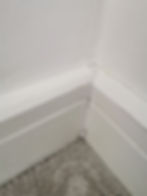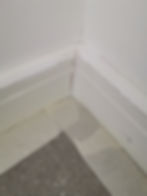7 Step Guide To Filling Gaps and Cracks in Skirting Board
- Matt Brooke
- Sep 9, 2019
- 4 min read
Since we moved into our new home and everything has started to settle most of the wood work has some cracks or gaps which has been addressed as we've decorated round the room. This is a typical example

I'm not a perfectionist but I like the paintwork to look a lot better than this. So here's my guide for filling those gaps and getting a great finish
Tools & Materials Required
Sandpaper - 120grit or similar (aka Medium grit)
Sandpaper block
Sharp knife such as a snap off blade
Decorators Caulk
Emulsion paint for the wall
Cutting in brush 25mm width or similar
Wide Masking Tape
Quick drying satin wood paint*
*We love using this as it doesn't go yellow and it dries quickly without giving a strong smell when painting. It's no where near as durable as oil equivalents but I'd suggest is fine for Skirting boards and doors. We normally go for wilko.com own brand.

Step 1 - Cut out old caulk and smooth the area
Sometimes when the wood contracts the old caulk clings on in a wavy pattern. Cut this out using a knife and smooth down the flat edges of the wood using the sandpaper wrapped round a block so that any bumps are flattened down and the paint looses any sheen it still has. Depending on your block and sandpaper size, you'll need to cut the paper to fit. Make sure the paper gets replaced as it wears down as it'll take you longer than it needs to overwise. A full A4 size sheet should be enough for the doors, skirting board and window sill of a 4m x 4m room.

Step 2 - Apply the caulk to the gaps
Firstly, accept it will look worse before it gets better, trust me! So now you have even bigger gaps in the woodword, time to fill them with the decorators caulk. When you open a new tube of caulk you'll need to cut the end so you get as big a nozzle as you need. I usually go for a very narrow opening so I don't get too much out at once.

You can always go back and apply more if needed. Insert the caulk bottle into the trigger and apply some pressure so the caulk fills the nozzle. Now hold the nozzle against the gap and drag slightly along the gap as you apply pressure to squeeze the caulk out. If it's a wide gap as per my photo, i'd advising applying the caulk to either side of the gap. If you squirt it down the middle it'll probably just fall through the gap. Working in sections, run your finger along the caulk to press it into the gap and smooth it out. Would advise keeping a damp cloth to wipe your finger on for this. Leave to dry as per caulk instructions.

Step 3 - Wipe Over Paintwork
Using a damp cloth or rag, wipe the dust and any loose debris up from the area to be painted. Rushing or skipping this step will impact on your final finish
Step 4 - Paint the walls
We have gone for the same colour on our walls and woodwork - a nice plain and crisp white. Make sure anything not being painted is covered up with dust sheets! I've not documented on how to paint walls, I may do another post on that but if you're going for one colour on walls and ceiling, it's by far the easiest way to go.
Emulsion paint is really easy to work with so you can usually wipe it up pretty easily. If you do get any on the woodwork, I'd suggest gently wiping it off with a damp cloth, taking care not to wipe it back off the walls where it's supposed to go
Step 5 - Mask
Assuming you aren't lifting up your carpet, I'd suggest you run a broad strip of masking tape as close to your skirting boards as you can without them touching the wood. I normally stretch out a piece about 80cm long at a time and press firmly against the edge between skirting board and carpet. Work in one direction around the room ensuring there are no gaps.

Step 6 - Paint the Wood
I'd give the emulsion paint at least an hour, maybe a few more to dry before painting any woodwork. This is where I'd say you need to take the most care to get a good final finish. For a right handed individual as myself I found it much easier to work clockwise round the room. There's loads of video's on t'interweb on how to paint nice straight edges if you need some help but i'd simply recommend using a cutting in brush, load up the brush with paint, spread some on the larger areas and then carefully drag the paint along the final detailed parts before brushing everything over to get a smooth and flat finish. Take your time in particular where you need to be neat as in the top where the wood meets the wall or the bottom where the wood meets the flooring. Depending on the manufacturers instructions the paint is usually ready for a second coat after 2-3 hours and the paint I use rarely needs more than two coats.

Step 7 - Remove Masking Tape
This is an important piece of advice. Try to remove the masking tape before the final coat dries! Doing this means it's less likely to pull off your new paint when it's being removed but as the masking tape will contain wet paint, you need to be extra careful not to get it on the flooring!
Once the paint has dried enough for you to not easily damage it it's time for the least enjoyable, underrated and most satisfying bit, tidying up! You can now stand back and admire the hard work you've done and begin to put the furniture back into it's rightful places.

